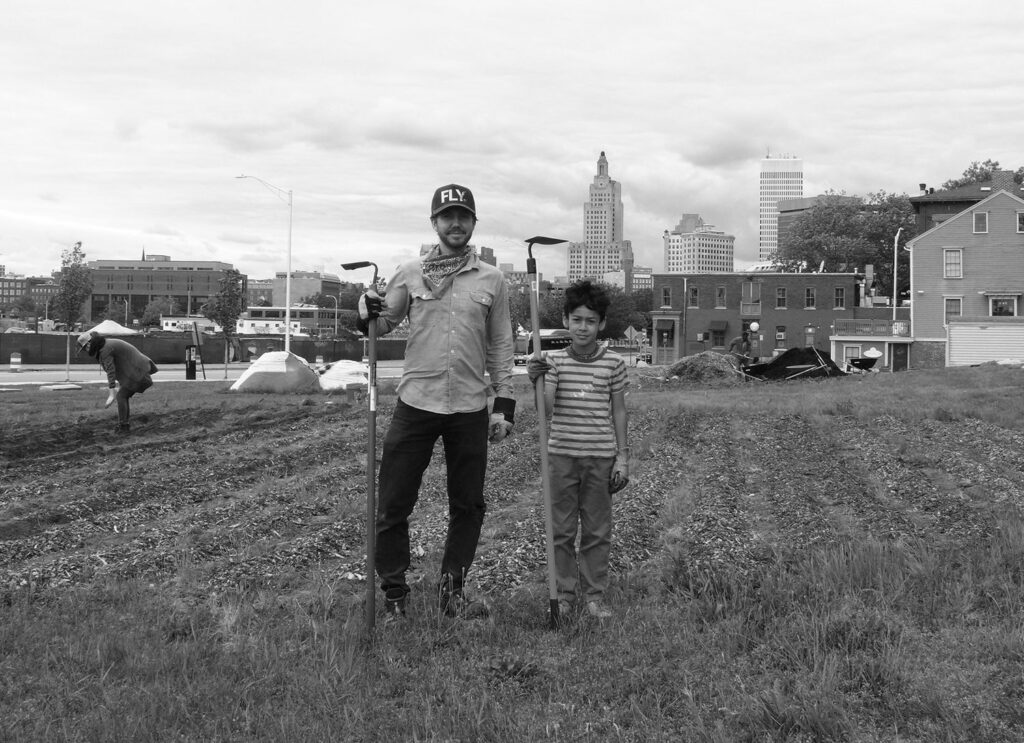
If you’ve ever taken a stroll by the Providence River and found yourself enthralled by a field of sunflowers glowing in that golden summer light, then you’ve experienced the wonder of Adam Anderson, director/founder of landscape architecture studio Design Under Sky.
Since 2016, the sunflower field, known as 10,000 Suns, has grown on a parcel of land that was once a section of I-195; now, it’s a parcel of land slated for development. An apartment complex will go up where the flowers once grew. That might feel like such a loss, but Anderson sees things a little differently.
“I think there’s part of it that’s kind of beautiful,” he says. “It becomes a story of Providence for the people who got to see it and experience it, and when those people see the new buildings they’ll be like, ‘Remember when that used to be a sunflower field?’ And someone else will be like, ‘What? Really? Whoa.’ I think that’s kind of nice.”
In addition to his work as a landscape architect, Anderson teaches at RISD and is also a writer. In fact, he started Design Under Sky in 2008 as an outlet for his writings about landscape design, wilderness, the anthropocene, botanical counter terrorism and the definition of nature, to name a few. By 2014, his online journal of thought-provoking essays evolved into a landscape design studio that interweaves the wonder of wilderness into its work.
“I think we now are sort of programmed to find wonderment in the technological,” says Anderson. “But I very much find it in the living world, by just looking at a flower. I feel like I have the sensibilities to be freaked out and amazed at how impossibly interesting and complex the living world is, and I very much have an interest for people to discover that.”
Wilderness plays a central role in Anderson’s work. He himself has a no-mow garden, which is a mix of red fescue and clovers he describes as a “textural carpet.” He loves the ephemerality of bulbs, of tulips and daffodils, how they pop up in spring.
“I also have lots of seed mixes I’ve planted, so random things kind of come up, like goldenrods and lupines. And then there’s a lot of weeds that grow up too, that I keep. I like when the pokeweed comes up and grows wild, I just let it go in the summer.”
In partnership with INFORM Studio, Anderson is currently at work on the Roger Williams Park Gateway and Visitor Center. With its entrance on Broad Street, the gateway begins as an urban pavilion then transitions into an urban garden with meadow-like plantings, meandering paths, log bridges, a rain garden and a treetop tower. The idea being: the farther you walk, the wilder it gets.
“My projects are a little more on the wilder side to maybe subconsciously or consciously try to change a little our perception of the image of nature… By having wilder things within the city, does that bring us a little bit closer to that? I guess it’s a change in what we accept as an aesthetic and a step in the direction of increasing the sensibilities of feeling wild.”
And that is what Anderson’s work accomplishes:, it informs our connection to wilderness and satiates a desire for the wild.; Hhe imbues the city with pockets of wilderness that compel even technophiles to look up from their screens and get lost in a meadow.
“The Living Edge project I did was a small thing. But when you go to it you’re sitting in a pretty wild meadow, you’re immersed in something, and it helps you;, you feel a little bit of displacement in the city, which I think we all need. Anywhere we can squeeze that in is beneficial.”
This displacement is part of the distinct feeling of experience ofing wonder in an urban wilderness. There’s a blurring of the lines, a marriage of sense and sensibility, a marrow-deep acceptance of humans as part of nature, as engineers with great minds capable of creating their own landscapes. TAnd there is also a sorrow that comes from looking back wistfully and recalling what was and no longer is; b. But if you look for it, you’ll see a breeze sift through the tall grasses, and the reflection of a meadow move like waves against glass windows, and wild shadows dance across concrete and stone, and then, that distinct feeling of wonder will return and any sorrow for the past will evolvehave evolved into a curiosity for the present.
“When people say ‘nature,’ really they’re just talking about the living world in general, and that can exist sort of anywhere… So for me, it’s felt very freeing to dismiss this idea of the separation between those things., Iit frees up the possibilities for looking at how we can really start to intermingle and integrate and, you know, become something different.”
To learn more about Anderson’s projects and to read his writings, visit designundersky.com.



